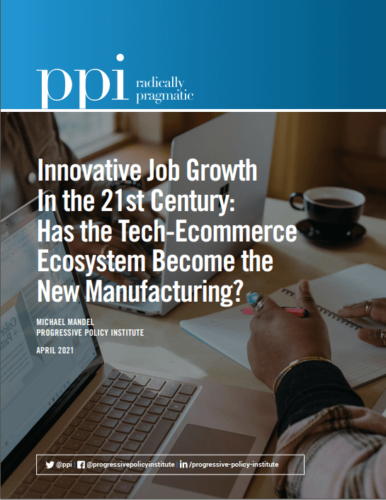Technological innovation, in turn, enabled these pioneering companies to become potent sources of good-paying jobs for U.S. workers. Collectively they employed millions of Americans, collaborating with smaller suppliers to form overlapping industrial ecosystems that supported communities in rural and urban areas across the country. Kodak was the classic example, of course, with the company’s powerhouse position in photography fueling the rise of its headquarters and main manufacturing center in Rochester (NY).
Manufacturing employment in the United States peaked in 1979. Since then, the sector has been a drag on job growth. Big companies have shrunk, consolidated, or disappeared. The once vibrant web of manufacturing suppliers has atrophied, with much of the supply chain now outside the country. And states where manufacturing once ruled have seen factory jobs dwindle, in some cases to almost nothing. In 1979, factory jobs accounted for more than one-third of the private workforce in 21 states, topped by South Carolina and North Carolina with fully 43% and 42% of their private employment in manufacturing. By 2019, those states were down to 15% and 13% of jobs, respectively, in manufacturing.
Instead, the mantle of global innovation leadership has shifted to America’s tech-ecommerce ecosystem. And perhaps surprisingly, so has the role of job creator. As we see in the next section, the top five tech-ecommerce firms—Apple, Alphabet, Microsoft, Facebook, and Amazon—employed 1.8 million workers globally as of early 2021. By comparison, the top 5 industrial firms by stock market value in the peak manufacturing employment year of 1979—GM, GE, IBM, Kodak, and Dupont—had a total global employment of 1.9 million, just slightly more.
By our calculations, the tech-ecommerce ecosystem—including both large and small employers—has arisen to become the top job creator in the U.S. economy. Based on data from the Bureau of Labor Statistics, the industries in the tech-ecommerce ecosystem (described
below) generated more than 1.2 million net new jobs from 2016 to 2020, including the pandemic. The next biggest growth sector was healthcare and social assistance, with 700,000 net new jobs created.
Moreover, average pay in the tech-ecommerce ecosystem, even omitting the headquarter states of California and Washington, is 44% higher than average pay in the rest of the private sector, and 21% higher than average pay in manufacturing nationally. This calculation is based on looking across all roles and positions in the tech-ecommerce ecosystem, from fulfillment center and delivery workers to software developers and AI experts.
In this paper, we analyze the historical role of manufacturing in job creation in the twentieth century, going back to the founding of General
Motors in 1909. Based on the metrics we calculate, we find that the tech-ecommerce ecosystem is as economically important to overall job growth today as manufacturing was during the postwar period.
Delving deeper into today’s tech-ecommerce workforce, we find that the distribution of pay in the tech-ecommerce ecosystem is spread out far more evenly than in the manufacturing sector. Manufacturing jobs are heavily concentrated in occupational groups with average hourly pay of $20 or less, based on data from the BLS Occupational Employment Statistics program. By contrast, the techecommerce sector has a relatively even distribution of low, middle, and high-paying jobs.
One concern is that tech-ecommerce jobs are excessively concentrated geographically in a few states, while manufacturing has historically been an important source of jobs over a wider area. In order to examine this issue, we developed three new tools to analyze the geographic impact of the tech-ecommerce ecosystem.
We conclude with a brief consideration of the future of tech-ecommerce ecosystem jobs. Note that this paper draws on earlier PPI research, namely our 2017 papers, “An Analysis of Job and Wage Growth in the Tech/Telecom Sector,” and “How Ecommerce Creates Jobs and Reduces Income Inequality.”
Read the full paper here.
